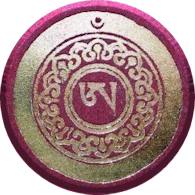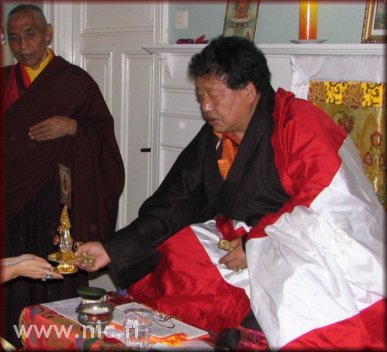
Akong Rinpoché Establishing Buddha-Dharma
Part Thirteen: Rinpoché's Work Introducing the Practices
 Lineage was important to Akong Rinpoché. He sometimes explained that one of his main tasks was to properly bring the lineages of the “Three Vows” properly to the West. These are respectively:
Lineage was important to Akong Rinpoché. He sometimes explained that one of his main tasks was to properly bring the lineages of the “Three Vows” properly to the West. These are respectively:
![]() 1. The pratimoksa vows of Refuge, lay precepts and monastic ordination
1. The pratimoksa vows of Refuge, lay precepts and monastic ordination
![]() 2. The two aspects of the bodhisattva vow and
2. The two aspects of the bodhisattva vow and
![]() 3. The various transmissions of Vajrayana, summed up as the transmission of empowerment, scripture and practice instructions along with samaya guidelines.
3. The various transmissions of Vajrayana, summed up as the transmission of empowerment, scripture and practice instructions along with samaya guidelines.
Akong Rinpoché spent his life in total dedication to preserving and perpetuating these three types of lineage and, where appropriate, having them introduced into the world at large. Many thousands of people have led lives of purity due to these efforts of his.
One can consider his own direct activities in these fields [1] as having three key periods:
• The early days of Samye Ling, when he gave Refuge, the aspiration bodhisattva vow only very occasionally in private and did not give any empowerments in public.
• A long period during which he invited many visiting rinpoches to give the three levels of transmissions and encouraged people to receive, from these unique masters, the blessings of such pure transmissions. He presented the bodhisattva vow as a very serious and profound commitment and wanted people to receive from only the greatest of living bodhisattvas—the Gyalwa Karmapa, the Goshir Gyaltsabpa, the Tai Situpa or Kalu Rinpoché. He continued to give Refuge throughout these decades, as well as the basic five precepts to anyone who requested them.
• A time, mainly after the Shamarpa breakaway, when the other rinpoches who had previously visited were unavailable to our centres and there was no other trusted Karma Kagyu master resident in Europe able to give empowerments. This coincided with the period mentioned elsewhere in this document in which Rinpoché no longer wished to give dharma teachings. In this third period, he gave empowerments, scriptural transmissions, occasionally some practice instructions, the aspiration bodhisattva vow (reluctantly ) and Refuge and precepts.
One very positive development due to Rinpoché during the latter period was the way in which he made sure the empowerments he gave were understood. In the first decades of visits by eminent masters to the West, they gave empowerments with people having very little idea about what was happening during the ceremony and what they were supposed to be doing, thinking or saying. In those days people watched what other people were doing and just copied them. It was a mysterious ritual through which one knew, or assumed, one had received transmission of the practice. There were sometimes comical moments when the people coming up to be touched by the various objects used in an empowerment had no idea whether to bow, stretch out a hand, drink the water poured into it or carry it away and so forth. Wanting people to understand and to do things more properly, Rinpoché started giving me the empowerment texts he was going to use and asking me to translate them—not always completely—with a view to explaining to people, either before or during the empowerment, what each step signified, what they were supposed to be visualising or saying or doing and so forth. Peter Roberts also did some work with empowerment texts for him.
 A pattern emerged whereby his main helper (mainly Gelong Thubten, the Samye lamas in London or Spain or myself) for the occasion would explain to those gathered what was about to follow, for up to an hour sometimes while Rinpoché himself prepared his part of the empowerment ceremony, and then Rinpoche would enter and perform the ceremony. Being prepared in this way made a big difference
for those attending. Even if they could not remember everything they had been told, they had
a much clearer idea of what was happening and, more generally and importantly, as they attended one initiation after another, came to understand much better the role of the Vajra Master giving the empowerment. Furthermore, Akong Rinpoché asked his helpers to give talks so that people understood the necessity of properly receiving empowerment/initiation, scriptural transmission and proper practice instructions in Vajrayana.
A pattern emerged whereby his main helper (mainly Gelong Thubten, the Samye lamas in London or Spain or myself) for the occasion would explain to those gathered what was about to follow, for up to an hour sometimes while Rinpoché himself prepared his part of the empowerment ceremony, and then Rinpoche would enter and perform the ceremony. Being prepared in this way made a big difference
for those attending. Even if they could not remember everything they had been told, they had
a much clearer idea of what was happening and, more generally and importantly, as they attended one initiation after another, came to understand much better the role of the Vajra Master giving the empowerment. Furthermore, Akong Rinpoché asked his helpers to give talks so that people understood the necessity of properly receiving empowerment/initiation, scriptural transmission and proper practice instructions in Vajrayana.
Rinpoché ensured the proper transmission of the Karma Kagyu lineage by requesting its greatest teachers to give its special empowerments. The transmissions of the key practices and guru-yogas needed for the long retreats were given by the Gyalwa Karmapa, Kalu Rinpoché and Khenchen Thrangu Rinpoché. The Goshir Gyaltsabpa and Kalu Rinpoché were requested by him to give transmission for the Chod and Mahakala practices. Many other rinpoches, too numerous to mention, were requested to give transmission of the more common practices such as Chenrezik, Green Tara, White Tara, Amitabha, Guru Rinpoché (Köncho Chidu) and Medicine Buddha. Empowerments for these common practices, along with the guru yogas of Milarepa and Karma Pakshi, were the ones that Akong Rinpoché mainly gave in Europe and Africa, enabling thousands of people to enter into these practices. Besides setting people on the path of their individual dharma practice, Rinpoché was also keen for people to take part in group practices, whereby the goodness (punya) gained is multiplied for everyone participating.
[1] Being a married lama, he could not give the monastic ordinations of course. He put great effort into having pure teachers, such as Khenchen Thrangu Rinpoche, give these in his centres.
.....this narrative continues: Establishing the Kagyu practice dharmas of grol lam, the Mahamudra trainings, and thabs lam, i.e. Traditional Long-Term Retreats and in particular the Six Yogas of Naropa.
